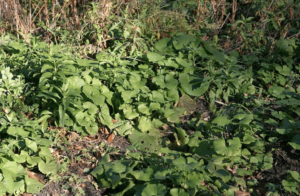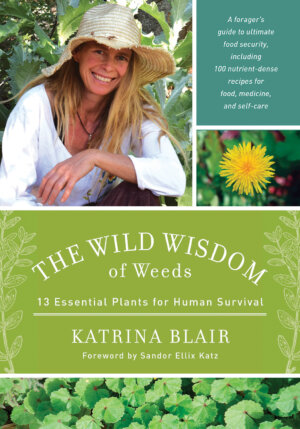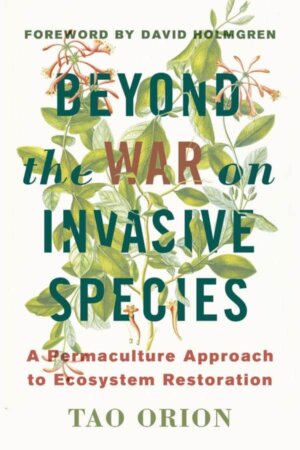Garlic Mustard — A Gold Mine of Food and Medicine
Not all invasive plants are necessary to get rid of. Garlic Mustard, for example, has been consumed for hundreds of years and has great nutritional value. Almost the entire plant can be used to promote a healthy body-leaves, seeds, and roots!
Also, the garlic-flavor is a perfect addition to any recipe that calls for mustard.
The following are excerpts from Beyond the War on Invasive Species by Tao Orion and The Wild Wisdom of Weeds by Katrina Blair. They have been adapted for the web.
Classification: Alliaria petiolata
Geographic location: Northeast, Midwest, Southeastern Canada
Description: Garlic mustard is a herbaceous biennial plant growing from a thin, white taproot. In the first year, plants appear as a rosette of green leaves close to the ground and develop into mature flowering plants the following spring. Second year plants range from 30–100 cm in height. The leaves are stalked, triangular to heart-shaped, and have a coarsely toothed margin. The flowers come in button-like clusters and each has four white petals arranged in a cross.
Peeling Back the Layers of Garlic Mustard’s Ecological Story
Garlic Mustard is from the family Brassicaceae, a botanical family with many members renowned for their vitamin, mineral, and antioxidant profiles. Garlic mustard is considered a choice edible plant in Europe where it is native. Many types of pollinators visit garlic mustard’s flowers, and though it is vilified as an invasive species in the northeastern US, its presence, like all other invasive species, tells an important ecological story.
Prior to the arrival of European immigrants, indigenous people that lived in the eastern United States cultivated edible and medicinal plants like elderberries, goldenseal, and ginseng in the understories of open canopied hardwood trees including sugar maple, shagbark hickory, and black walnut. Stands of these and other plants were managed with fire, as well as cultivation through digging, seed-saving, and vegetative propagation. Directing and managing ecosystem succession with perennial polycultures was (and is still in some places) a feature of many indigenous societies that have historically been labeled ‘hunter-gatherers.’
From the Amazon rainforest to the deserts, savannahs and jungles of Indonesia, Africa, Australia, and Central America, to the prairies and hardwood forests in North America, people were cultivating crops, and though it looked much different from the European and continental Asian version of agriculture, these practices structured and modified ecosystems in important ways.
Those species that are now known as native in the Americas and elsewhere are relics of historic forest gardens. The wilderness ideology of leaving nature alone (in certain places) that permeates the philosophy of American land use means that many ecosystems now lack the type of management that made them so historically diverse and abundant. Lack of consistent cultivation and management of native species means that there are ecological niches available for invasion, as the process of succession is inevitable, and succession is all about invasion – whether the species coming in are native or not.
 Garlic mustard confounds many land managers because it invades what are considered ‘pristine’ forests that haven’t been logged or otherwise cleared. It appears to displace native vegetation with its prolific growth.
Garlic mustard confounds many land managers because it invades what are considered ‘pristine’ forests that haven’t been logged or otherwise cleared. It appears to displace native vegetation with its prolific growth.
However, what’s really going on in this case is a lack of cultivation of those native species. Ginseng and goldenseal require not just judicious harvesting, but propagation and tending to thrive. Elderberries need adequate light to set prolific fruit, and hickories and walnuts are more productive when they have space for their lateral branches to grow unobstructed.
One of the best ways to manage garlic mustard and similar species? Focus on providing optimum conditions for the native understory plants.
In the process of doing this, you can obtain a yield of garlic mustard, which is quite tasty and nutritious. With consistent harvests over the course of several years, the garlic mustard will be less vigorous, and hopefully the understory and other species you focus on cultivating will begin to thrive again. This will ensure that the ecological functions that garlic mustard currently serves (pollinator forage, vigorous soil-conserving understory) will be maintained as the ecosystem shifts toward a more diverse species profile. And perhaps you will find that you prefer to keep some garlic mustard as a well-managed part of your now thriving perennial edible forest garden. Garlic mustard sauerkraut anyone?
Garlic Mustard: A Gold Mine of Food and Medicine
 Garlic mustard, growing as a ground cover in many places in the country, is a gold mine of food and medicine. We are blessed when a plant such as the garlic mustard shows up in abundance. Some might feel threatened by its prolific growth and fear that it may be out of control, but we might also choose to relax and trust in nature and the natural succession that has been happening in wild places across the globe over millennia.
Garlic mustard, growing as a ground cover in many places in the country, is a gold mine of food and medicine. We are blessed when a plant such as the garlic mustard shows up in abundance. Some might feel threatened by its prolific growth and fear that it may be out of control, but we might also choose to relax and trust in nature and the natural succession that has been happening in wild places across the globe over millennia.
All mustards are edible, and garlic mustard has a special pungent garlic-like flavor, perfect for adding to a host of recipes. All parts of the mustard plant have a valuable quality that helps stimulates circulation of the blood. And when our body has a good exchange and movement of fluids there is a heightened communication between our organs, tissues and cellular matrix. This activity promotes optimal health through greater efficiency of regenerating tissues and effective elimination of wastes.
Mustard leaves can be added to green juices for an added zest in flavor. When collected, dried and mixed with salt, the greens are great for seasoning dishes. The nutrient dense seasoning powder not only tastes delicious but provides our body a rainbow of minerals that are not readily found in conventionally grown foods. Garlic mustard greens are high in Vitamin A and Vitamin C as well as trace minerals, chlorophyll and enzymes. The roots taste like horseradish and can be pickled or used in soups as a root vegetable. The seeds when ground make a fabulous mustard sauce and the dried greens can be made into a paste like wasabi.
When we bring the wild greens, roots, flowers and seeds into our daily diets through salads, soups, juices and seasoning, we benefit from a greater integrity of health and well being. There is a core integrity that comes from wild harvesting our foods from the wild places on earth. Garlic mustard is out there growing in nature’s garden. We didn’t plant it, nor weed it, nor even water it. All we have to do is ask permission, take what we need and say thank you.

